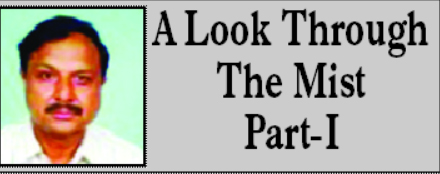Ambedkar focussed on powers resting in elected Legislature but also with a check on elected leaders

DAYA SAGAR
Labour Party of ‘England’ expressed willingness to grant freedom to India if voted to power and also won 5th July 1945 elections.
Clement Richard Attlee, the Labour Party leader, after he became Prime Minister of United Kingdom had sent Cabinet Mission, a high-powered mission.
In February 1946 to India with three British Ministers – Pethick Lawrence, Stafford Cripps, & A.V. Alexander as members-to discuss/ deliberate on the transfer of power from British to Indian leadership and getting framed a Constitution for India through a designated body like Constituent Assembly.
The Mission’s proposals of May 1946 though did not find total acceptance but principal spirit lying in ‘transfer of power’ to Indians did set its roots, Elections were held for a Constituent Assembly of India to frame the constitution for ‘free’ India even before Indian Independence Act 1947 of Parliament of United Kingdom ( Britain) was passed in July 1947. For Constituent Assembly of free India of future, members were chosen by indirect election by the members of the Provincial Legislative Assemblies in terms of a single transferable vote of proportional representation (according to the scheme recommended by the Cabinet Mission). In the first meeting (Muslim League boycotted league demanded partition of India),9th December 1946, of the Constituent Assembly at New Delhi Dr Sachidanand eldest member was elected interim President.
On December 11, 1946, Dr. Rajendra Prasad was elected as the President and H.C. Mukherjee as the Vice-President.
Those who adorned the front row included Pandit Jawaharlal Nehru, Maulana Abul Kalam Azad, Sardar Vallabhbhai Patel, Acharya J.B. Kripalani, Dr. Rajendra Prasad, Smt. Sarojini Naidu, Shri Hare-Krushna Mahatab, Pandit Govind Ballabh Pant, Dr. B.R. Ambedkar, Shri Sarat Chandra Bose, Shri C. Rajagopalachari and M. Asaf Ali.
On 13 December, 1946, Pandit Jawaharlal Nehru moved the Objectives Resolution that among others included ::”This Constituent Assembly declares its firm and solemn resolve to proclaim India as an Independent Sovereign Republic and to draw up for her future governance a Constitution; Wherein the territories that now comprise British India, the territories that now form the Indian States, and such other parts of India as are outside British India and the States as well as such other territories as are willing to be constituted into the Independent Sovereign India, shall be a Union of them all; and ..” The Resolution was unanimously adopted by the Constituent Assembly on 22nd January 1947. In view of the expected partition of India & taking leads from the Mountbatten Plan of 3rd June, 1947, a separate Constituent Assembly was to be set up for Pakistan hence the membership of the Constituent Assembly for India Dominion was reduced to 279 ( 229 were from the British Indian provinces while the remaining 70 were from the princely states ).
The Constituent Assembly had made (On 29th August, 1947 ) 17 committees including the one as Drafting Committee for constitution with Dr Bhim Rao Ambedkar as Chairman – i.e. With Rajinder Prashad a Chairman 1. Committee on the Rules of Procedure, 2. Steering Committee 3. Finance and Staff Committee, 4. Adhoc. Committee on the National Flag, Rajendra Prasad CM 5. Credential Committee, Alladi Krishnaswami Ayyar CM 6.House Committee ,B. Pattabhi Sitaramayya CM 7.Order of Business Committee, K.M. Munsi CM 8. Committee on the Functions of the Constituent Assembly, G.V. Mavalankar CM 9.Excluded and Partially Excluded Areas (Other than those in Assam) Sub-Committee, A.V. Thakkar CM 10.Advisory Committee on Fundamental Rights, Minorities and Tribal and Excluded Areas, Vallabhbhai Patel CM 11. Minorities Sub-Committee, H.C. Mookherjee CM 12.Fundamental Rights Sub-Committee, J.B. Kripalani CM 13.North-East Frontier Tribal Areas and Assam Excluded & Partially Excluded Areas Sub-Committee, Gopinath Bardoloi CM.; with Jawahar Lal Nehru as CM States Committee,15. Union Powers Committee 16.Union Constitution Committee.
It was in June 1947 that British Parliament finally enacted Indian Independence Act 1947 which was assented by the British Crown (King of Britain) on 18-07-1947 laying down “An Act to make provision for the setting up in India of two independent Dominions, to substitute other provisions for certain provisions of the Government of India Act, 1935, which apply outside those Dominions, and to provide for, other matters consequential on or connected with the setting up of those Dominions ” Where Section-1 of the Act said ” 1.-(i) As from the fifteenth day of August, nineteen hundred and forty-seven, two independent Dominions shall be set up in India, to be known respectively as India and Pakistan. (2) The said Dominions are hereafter in this Act referred to as the new Dominions “, and the said fifteenth day of August is hereafter in this Act referred to as ” the appointed day “.
Based on detailed studies of world democracies and governments like Great Britain (The Constitution of the United Kingdom or British)/ US /USSR/ etc , the reports / suggestions from different committees the Constituent Assembly Secretariat under the guidance of B N Rau ICS 1909 ( Mr. B N Rau , was a very experienced civil servant during British times and had also wide experience of governance /needs of Indian communities , ofcourse he was not made the member of constituent Assembly but was retained as Constitutional Advisor ) had prepared the draft sketch of the constitution by Oct 1947 for further action by the Drafting Committee / core committee of experts which was submitted to President of the Constituent Assembly on 21-02-1948 for final actions/ modifications / structuring by the Drafting Committee headed by Dr B.R Ambedkar and discussions/ debates / modifications / approvals by the Constituent Assembly.
Two hundred and seventy nine representative members including nine women were there in the Constituent assembly. To be contd
(The author is a Sr Journalist &
analyst of J&K Affairs. [email protected]).
